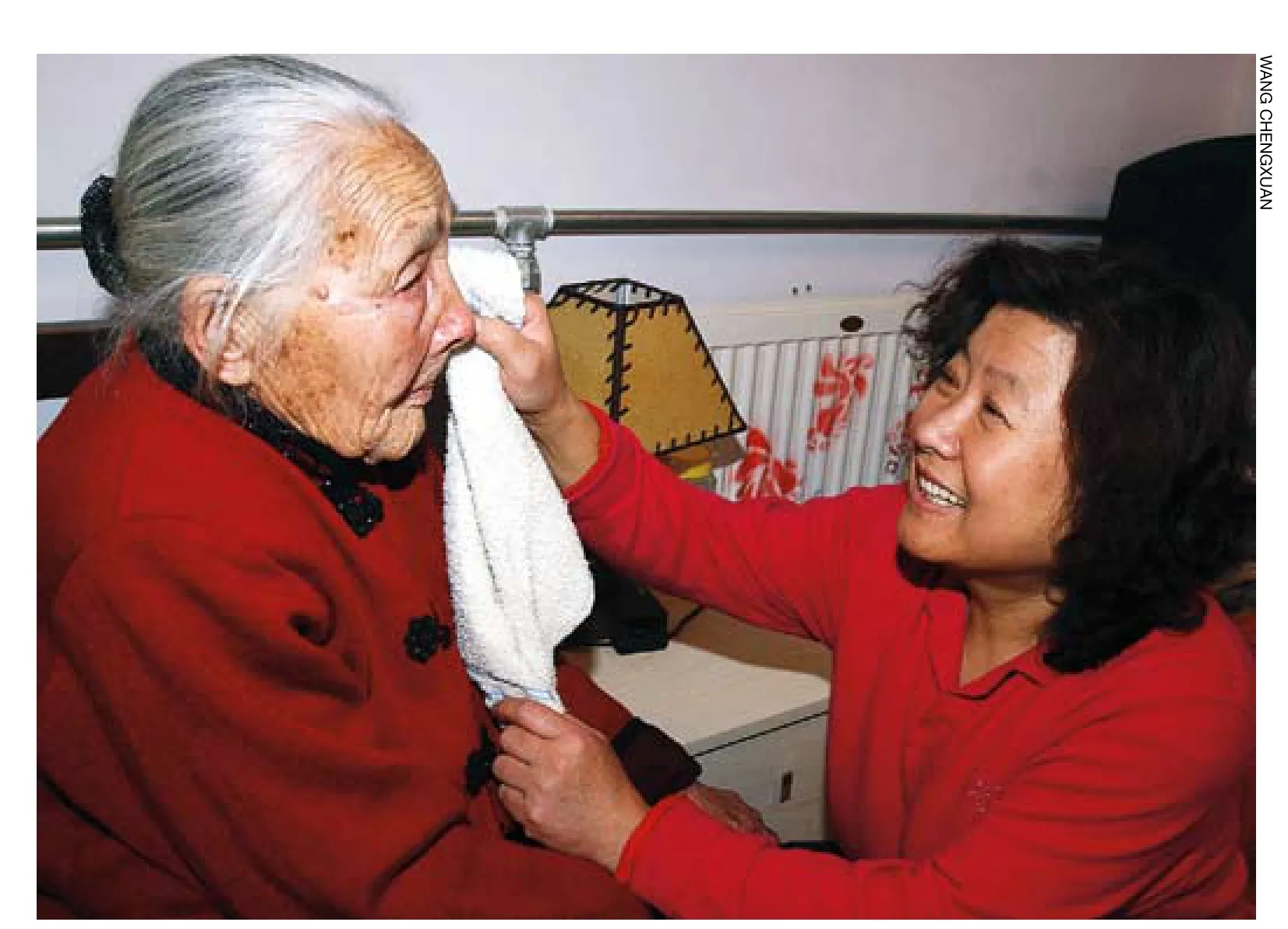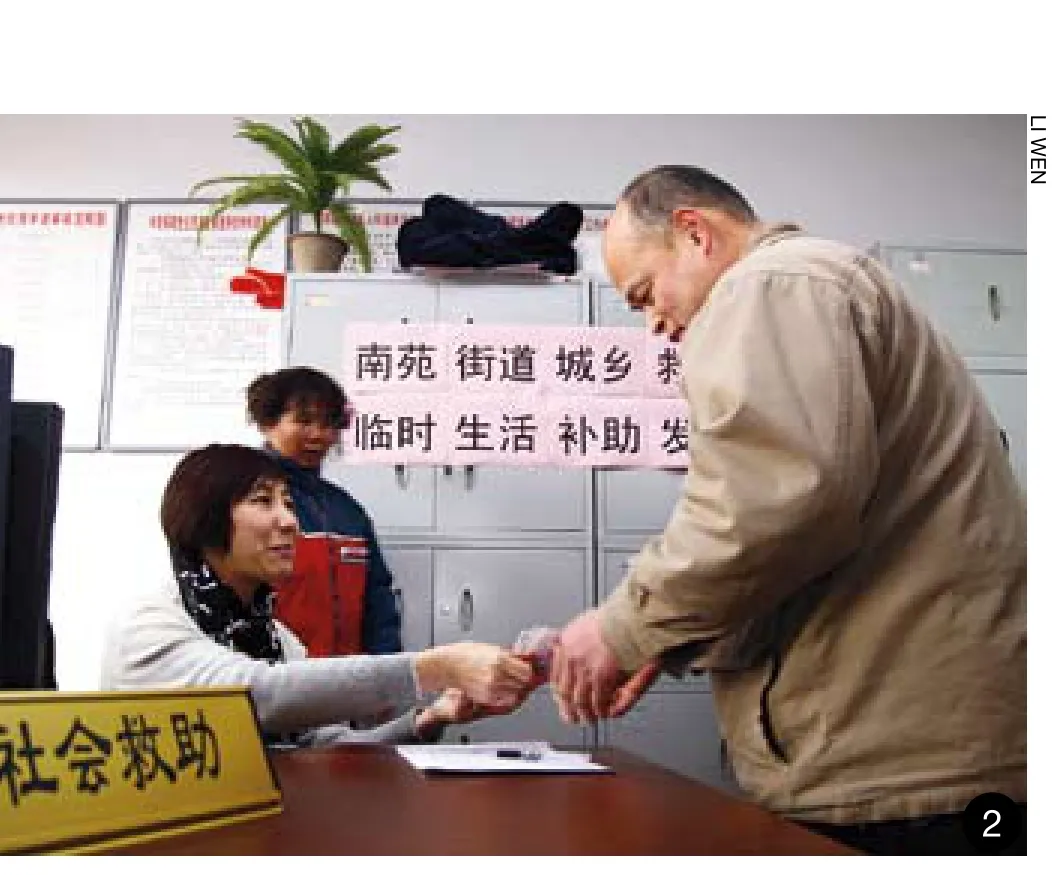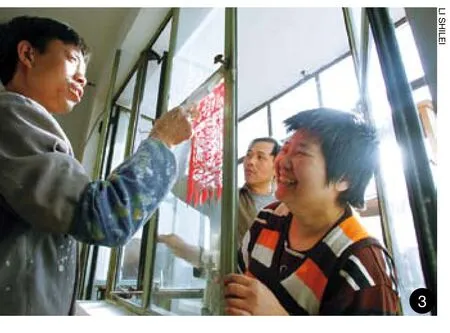Tackling Urban Poverty
2011-10-14ByYINPUMIN
By YIN PUMIN
Tackling Urban Poverty

HELPFUL NEIGHBOR: Zhang Pinzheng (right), a resident in Beijing’s Tongzhou District, takes care of her neighbor Jin Xuzhen, a 100-year-old widow with no income
The survey also revealed that only 30 of the poor families had a steady source of income, and their average income was 1,262 yuan ($198) per household, whereas the average monthly salary for a Beijing urban employee in the same period was 3,726 yuan ($584).
New urban poverty
“Urban poverty has become an increasingly salient issue,” said Song Yingchang, a researcher with CASS. “The percentage of urban residents living under the government-set minimum living standard has gradually increased from 1996 to 2009.”
But researchers admit urban poverty is relative.
The poverty line that CASS used to measure urban poverty was an average annual per-capita income of 7,500-8,500 yuan ($1,176-1,332).
Wei Houkai, a research fellow with CASS and the lead author of the blue book on China’s cities, said that at present there is no uniform standard to determine urban poverty. Economists usually defne absolute poverty in terms of the cost of a specifed basket of food and non-food items that are considered “necessary” to meet people’s basic needs, whereas relative poverty is determined in reference to the per-capita expenditure or income of a region.
“Fifty million was obviously an underestimate of the total number of urban poor in China,” said Chen Huai, Director of the Urban and Rural Development and Economic Research Institute of the Ministry of Housing and Urban-Rural Development.
“In the past, under the planned economy, people’s incomes were close to the per-capita level, whereas in the market economy the income gap has widened, leaving more people well below the per-capita fgure, and resulting in more relative poverty,” Chen said.
Ding Sibao, a researcher with the Shenzhen-based China Development Institute, said that urban poverty is a more diffcult challenge to solve than rural poverty as the urbanpoor do not have land to farm and feed their families. Unlike the rural poor, few impoverished urban residents migrate to other cities.

NEW SCHOOL UNIFORMS: Students in Beijing Chunjiang Primary School show off their new school uniforms donated by Chaoyangmen Neighborhood before International Children’s Day in 2010. Most students in the school are children of migrant workers
According to researchers, urban poverty did not become a major concern in China until the 1990s when China transformed from a planned economy to a market one.
Under the planned economy, when the government assigned jobs to urban residents, the urban poor were mainly orphans, the elderly and the disabled who had no ability to work, no savings or other income source and no relatives to depend on.
However, amid accelerated economic restructuring since the mid-1990s, many poorly performing state and collectively owned enterprises cut production or closed down. As a result, millions of workers have been laid off and their incomes sharply dropped.
According to a study by Zhu Qingfang, a researcher with CASS, there were 8.77 million laid-off workers who were not counted as unemployed in Chinese cities in 1998, while 5.71 million people were registered as unemployed and 0.6 million retirees’ pensions were in default. Assuming these 15 million people each supported one dependent, Zhu estimated that there were 30 million urban poor people at that time. There were also about 1 million urban orphans, elderly and disabled on the welfare roll of the government.
Song said that today the urban poor mainly consist of three groups of people—laid-off workers, migrant workers and fresh college graduates with low-paid or no jobs.
“Most of the poor with urban residence are already in their 40s or 50s, and they will retire in about 10 years,” Song said. In the market economy, the government no longer assigns jobs to urban residents. Many laid-off workers have diffculty fnding jobs because of their poor education and age.
China is in the process of rapid urbanization. Every year, 10 million rural people enter cities, but Song said 80 percent of them are poor. China’s urbanization process will continue for another three decades until the rate reaches 75 percent, and the number of urban poor is certain to increase.
Poverty alleviation
Given the scale of the problem, governments at all levels have taken action to alleviate urban poverty.
In the Maizidian Neighborhood, 56 of the 93 offcially poor families receive a minimum living allowance from the government, with a monthly payment of about 500 yuan ($77).
The government also insures the residents against serious diseases and unemployment, and some organizations, such as the local women’s federation and labor union, also offer some forms of assistance. “But most of this assistance is not long-term or regular,”said Sun Shouying, a social worker at the Maizidian Neighborhood.
China’s minimum living allowance system was established in the1990s. “At the end of 2010, a total of 23.11 million urban residents received this allowance,” Song said.
Before the 1990s, only those without the capacity to work and with no income or legal guardian were entitled to government relief.
Following massive layoffs from state and collectively owned enterprises in the 1990s, the Chinese Government promulgated in 1999 the Regulations on Guaranteeing Urban Residents’ Minimum Standard of Living.
The regulation stipulates that urban residents with non-agricultural permanent residence whose family’s per-capita income is lower than the local urban residents’ minimum living standard are entitled to the minimum living allowance from the local government.

1. FREE SERVICE: Seniors eligible for minimum living allowance receive free medical examination in Yinchuan City, Ningxia Hui Autonomous Region
But Sun said the minimum living allowance provides only marginal assistance to families that are often deeply indebted and coping with serious diseases. The system also places families with per-capita incomes just slightly above the official minimum living standard in a diffcult situation as they do not qualify for any government assistance.
Currently, most poverty alleviation NGOs in China do not have programs targeting the urban poor. “The rural poor are easier to target, and poverty alleviation can make a bigger difference,” said Guan Xinping, a professor in the Social Work and Social Policy Department of Nankai University in Tianjin.
The vast majority of urban poverty alleviation programs are conducted by neighborhoods. The Maizidian Neighborhood has launched a number of initiatives to help poor families. In 2007, it launched a Five-Support Program and mobilized local enterprises to offer fnancial support to needy families, and increase their access to medical services, education and employment.
“So far, the neighborhood has signed agreements with more than 100 enterprises that have promised to donate money or supplies every month,” Sun said.
Luo Peng benefted from the program. In 2008, two companies donated a computer to Luo and agreed to cover his Internet surfng expenses.
With access to the Internet, Luo studied English and computer animation, and opened an online store. He also contributes articles to an Internet portal and now has a monthly income of 1,000 yuan ($154). Although he still has to spend 3,000 yuan ($462) per month on medicine, Luo said that only partial self-reliance had already made him feel better both physically and mentally.
Ma Jian, who suffers from rachitis, a spine disorder, was a laid-off worker. Under the Five-Support Program, a hotel in the neighborhood offered his wife, who was also a laid-off worker, a job.
“Under the Five-Support Program, many poor families have gradually returned to a normal life,” Sun said.
While the program is extremely successful, a small number of families are found to become dependent on assistance.
“We try to fnd jobs for those people with the ability to work instead of just giving them handouts,” Sun said.
To help poor residents become financially independent, the neighborhood offers free training and career consulting services to unemployed residents and organizes regular job fairs.
Work incentives
How to protect people from poverty while giving them an incentive to work is a key issue in designing any poverty relief program.
Some minimum living allowance recipients prefer to live on the stipend rather than engage in low status jobs.
Regulations governing the minimum living allowance require local governments to promote employment and self-employment, and encourage working age allowance recipients with the ability to work to participate in community services organized by neighborhoods.
But, the regulations do not set a specifc time limit for the payment of the minimum living allowance although it requires a family to report income changes, so that the allowance can be increased, decreased or withdrawn.
“Yet in reality, it is very diffcult to stop living allowance payment as it is hard to know the actual incomes of recipient families due to fexible work hours and off-the-book incomes,” said Han Keqing, a professor at the Renmin University of China.
In June 2010, national audit authorities said that 62,900 ineligible households had received 330 million yuan ($52 million) worth of minimum living allowance from 194 district or county governments. About 18 percent of these households owned private businesses, vehicles or more than two apartments.
“The equity and efficiency of the minimum living allowance system will be undermined if it includes ineligible recipients or excludes eligible recipients,” Han said.
The Ministry of Civil Affairs announced last year that eligibility for the minimum living allowance would depend on assets including property, bank deposits, housing and vehicles. Previously, eligibility was determined only by a household’s per-capita monthly income.
However, Han cautioned that the minimum living allowance system alone is not enough to alleviate urban poverty. “The system should be combined with housing, education, medical assistance programs and with employment promotion,” he said.

2. GOVERNMENT RELIEF: A resident in Beijing’s Fengtai District receives living allowance from the government on November 25, 2010

3. HELP IN NEED: Workers repair the apartment of a poor family in Maizidian Neighborhood in Beijing’s Chaoyang District. The cost is covered by the neighborhood
By YIN PUMIN
According to a joint statement issued by the Ministry of Civil Affairs (MOCA) and the National Disaster Reduction Commission (NDRC) on October 10, natural disasters left 1,074 people dead or missing across China in the frst nine months of this year.
Between January and September, natural disasters affected 480 million people nationwide, resulting in the evacuation or relocation of 9.12 million people. The disasters also incurred a combined direct economic loss of more than 302.8 billion yuan ($44.33 billion).
“On average, natural disasters cost 2.38 percent of China’s GDP in the past 20 years,” said Fan Yida, chief engineer with the NDRC.
Fan said the country will make consistent efforts to improve its ability to prevent and mitigate disasters. The government’s aim is to keep the economic losses from such disasters to less than 1.5 percent of annual GDP.
Over the next fve years the government will work to ensure aid reaches people struck by natural disasters within 12 hours. Current disaster relief regulations require the victims should be guaranteed necessary supplies such as water and food within 24 hours of the occurrence of a disaster.
To respond to natural disasters more effectively, China is expected to train over 2.75 million people in disaster prevention and emergency management by the end of 2015.
Fan said disaster prevention and mitigation is an important part of the government’s public services. “We should give full play to the leading role of the government during the process and also encourage non-government organizations to take part,” Fan said.
Concentrated prevention
On May 10 of this year, a new national map of disaster-prone areas was released by the State Key Laboratory of Earth Surface Processes and Resource Ecology at the Beijing Normal University.
The map shows the eastern and central parts of China are highly prone to earthquakes, floods, landslides, typhoons and droughts.
“Because most eastern areas, especially the coastal regions, are fast-developing and have a large population, the damage from natural disasters would be heavy,” said Shi Peijun, Deputy Director of the National Committee of Disaster Relief, who was in charge of drawing up the map.
According to Shi, the main aim of publishing the map is to make people throughout the country more prepared in the event of a sudden catastrophe.
“The risk of natural disasters is rising in China and we may be entering a period with frequent extreme weather events and geological disasters,” Shi said, calling for intensifed efforts to mitigate these risks.
Since 2008, China has suffered several major natural disasters.
On May 12, 2008, an 8.0-magnitude earthquake jolted Wenchuan, Sichuan Province, claiming about 80,000 lives, injuring tens of thousands of others and causing a direct economic loss of about 845.1 billion yuan ($132 billion).
In April 2010, a 7.1-magnitude tremor hit Yushu, Qinghai Province; and in August last year, devastating mudslides killed about 2,000 people in Zhouqu, Gansu Province.
On March 10 of this year, Yingjiang County in Yunnan Province, a povertystricken area located near the border with Myanmar, was jolted by a 5.8-magnitude earthquake, which flattened thousands of homes and left 26 people dead and another 313 injured.
In order to improve its ability to prevent and mitigate disasters, the Chinese Government authorized the MOCA to establish the NDRC in 2002, which became functional in May 2003. In 2009, a satellite disaster reduction application center was established at the NDRC.
“Today, a 24-hour monitoring mechanism is in operation,” Fan said.
On September 6, 2008,Huanjing-1AandHuanjing-1B, China’s first two satellites dedicated to environment and disaster monitoring, were launched. Each satellite has two charge coupled device cameras, with a 30-meter resolution and a 720-km width, on board. According to the State Administration of Science, Technology and Industry for National Defense, the cameras can jointly scan and produce an image of China’s entire territory in two days.
This enables the two satellites to monitor a designated area multiple times and inform government agencies of potential disasters.
“The two satellites provide a stable, long-term data source that helps China fght disasters,” Fan said, adding a small radar satellite would be launched later this year to work with the two optical satellites.
Eventually, these satellites will form a constellation, which will provide 24-hour
assistance from the Five-Support Program. Under the program, Meng Qingjiang, who suffers from hemophilia, a bleeding disorder, receives 300 yuan ($46) a month from a sponsor company in addition to his monthly living allowance from the government. The additional allowance will be paid until Meng’s son graduates from high school.
